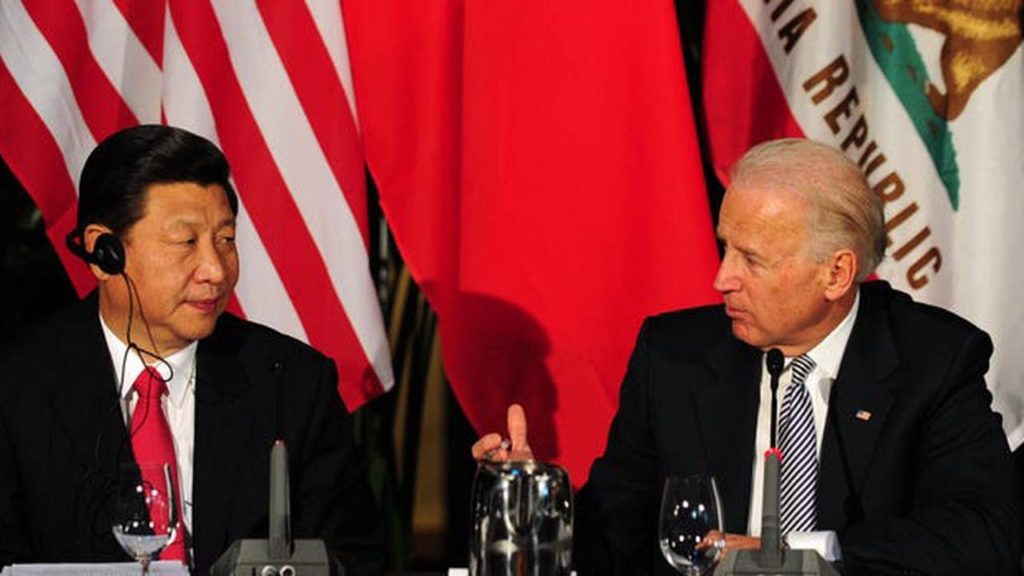Under Biden, the Fundamentals of Sino-US Relations Will Remain the Same

Then Vice President Biden met with Chinese President Xi Jinping at a 2012 meeting in California. Credit: Frederic J. Brown/AFP via Getty Images
By Shihui Yin and Inderjeet Parmar*
Over the past four years, Sino-US relations reached a post-Mao era low point. For now, with the newly-minted US administration, the biggest question facing the two countries is: to what extent will President Joe Biden’s China strategy differ from or resemble that of his transactional and aggressive predecessor?
It was three weeks after his inauguration that Biden held the first telephone call with Chinese President Xi Jinping. During the call, Biden stressed that China should expect ‘extreme competition’ from the US but, significantly, that this did not mean inevitable Sino-US conflict. He raised concerns over China’s ‘coercive and unfair economic practices’, Hong Kong, human rights abuses in Xinjiang and Taiwan. The two leaders also discussed global challenges such as the COVID-19 pandemic and climate change.
Like Trump, Biden’s rhetoric remains tough on China, but he is committed to steering a different approach, or policy-and-rhetorical mix, based on a focus on the rules-based order, and democracy. It appears that Biden’s team’s rhetoric will remain strident, but a clear recalibration of China policy is underway, one aimed at avoiding zero-sum mentalities, a balance between competition and cooperation. This may fall somewhere between Trump’s China as a “strategic rival” and the EU’s China as a “systemic rival” strategies. It signals the wary, turbulent, competitive-interdependence of the world’s two largest economies.
With regard to trade and economic relations, the Biden administration has a stronger emphasis on supporting US domestic competitiveness and innovation through direct federal action. Therefore, no criticism has been advanced on Trump’s trade war with China as damaging to US business. Biden inherits many of Trump’s (and Barack Obama’s) concerns over China’s trade practices and industrial policy.
Of course, the Trump administration took an aggressive stance towards China over economic and trade practices. It labelled China as a ‘strategic competitor’. The White House’s ‘2020 Strategic Approach to the People’s Republic of China’ states that ‘Beijing’s poor record of following through on economic reform commitments and its extensive use of state-driven protectionist policies and practices harm United States companies and workers, distort global markets, violate international norms, and pollute the environment.’
Despite being critical of Trump’s failure on those issues, Biden is continuing to address US concerns with China’s trade practices. Biden said, “I want to make sure we’re going to fight like hell by investing in America first in areas such as advanced materials, energy, artificial intelligence, 5G and energy as a way of generating more leverage to better compete with China, not just complaining about it.” He then added there is no immediate action to remove the 25% tariffs that Trump imposed on half of Chinese exports to the US.
‘America First’ and ‘Extreme Competition’ may not differ fundamentally after all.
Shipping containers being loaded onto Xin Da Yang Zhou ship from Shanghai, China at Pier J at the Port of Long Beach, California in 2018. Photo: Reuters/Bob Riha Jr
Biden and his advisors also inherit Trump’s tough posture such as ‘decoupling’ methods in tackling China’s technology transfer and industrial ambitions and strategies. The existing bans of Chinese companies including Huawei, ZET, and Xiaomi, and Chinese apps such as TikTok, will likely remain in place and possibly further escalate, signalling Biden’s turn towards Tech Cold War to crackdown on Chinese technology companies. Gina Raimondo, Biden’s pick for commerce secretary, said she would ‘use the bold toolkit at my disposal to the fullest extent possible to protect Americans and our network from Chinese interference or any kind of backdoor influence’. Biden also argued that ‘as new technologies reshape our economy and society, we must ensure that these engines of progress are bound by laws and ethics…and avoid a race to the bottom, where the rules of the digital age are written by China and Russia’. Getting American allies on the same page to set technology standards is also one major priority of increasing leverage to deal with China.
The Biden administration is likely to focus more on building domestic competitiveness to compete with the Chinese economy. While Biden has not yet articulated a systematic economic stance, particularly in the technology sector, toward China, a cooperative approach on trade and China’s industrial policy will be possible only when US interests are protected and maximised. His comment on ‘extreme competition’ serves as an important warning for China’s tech industry.
In terms of military strategy, Biden plans to continue Trump’s policies to counter China’s ‘military expansion’ (in its own regional waters) by sending ships through the Taiwan Strait, through naval exercises in the South China Sea. The difference is that Biden will consolidate a system of regional alliances and partnerships, including Japan, to meet the China challenge and could appear less aggressive than his predecessor. This is the strategy of ‘hegemonic ordering’ rather than bilateral transactional coercion, as Parmar and Turner suggest.
The Trump administration’s 2018 National Defence Strategy stated: “as China continues its economic and military ascendance, asserting power through an all-of-nation long-term strategy, it will continue to pursue a military modernization program that seeks Indo-Pacific regional hegemony in the near-term and displacement of the United States to achieve global pre-eminence in the future.” A strong US commitment was shown to Taiwan’s defence by selling sophisticated military hardware to Taipei. In 2020, US battleships transited the waterway thirteen times.
The Biden team has displayed signs to build on Trump’s commitment. A guided-missile destroyer was already mobilised by the US Navy through the Taiwan Strait for the first time under Biden. The US secretary of state Antony Blinken said this is to ensure Taiwan’s ability to defend itself against aggression and to demonstrate US long-term and strong bipartisan commitment to a free and open Indo-Pacific. Additionally, hours before his call to Xi, Biden announced a new China task force to review all China-related military policy and craft a comprehensive China policy including economic, political and diplomatic elements, pledging to counter the China challenge and ensure ‘Americans will win the competition of the future’.

US Secretary of State Antony Blinken begins his first press briefing at the State Department in Washington, US, January 27, 2021. Photo: Reuters/Carlos Barria
Another important element of President Biden’s approach will be rhetorically-underscoring human rights, democracy and liberal values as a part of ‘extreme competition’ with China. Biden and his advisors appear rhetorically-determined to forge common democracy and human rights-focused positions with European and Asian allies to impose costs on China’s actions in Hong Kong, Xinjiang and Taiwan. The key question is to what extent it might work with them together, particularly because regional Asian partners depend on China for trade and investment, and the EU is increasingly stressing its ‘strategic autonomy’, particularly in light of the instability of the US political system as broadcast most graphically on January 6, 2021.
Trump portrayed China’s authoritarian political system as a threat to the US and global interests. In 2020 his secretary of state, Mike Pompeo, reported to Congress that Hong Kong no longer merits ‘autonomous status’ from China, and before leaving office, he declared China’s repression of Uighurs as ‘genocide and crimes against humanity’ [Emphasis added]. In addition, the Trump administration signed the Uyghur Human Rights Policy Act of 2020, which authorises the imposition of US sanctions against the Chinese Community Party’s detention and persecution of Muslim Uighurs. This however contradicts his earlier support of Beijing’s internment camps in Xinjiang. Biden echoes Trump official’s genocide claims.
This hawkish stance was also echoed by Antony Blinken. The new secretary of state tweeted after the call with Yang Jiechi: ‘the US will defend our national interests, stand up for our democratic values, and hold Beijing accountable for its abuses of the international system’. A bipartisan Bill was reintroduced to ban imports from the Xinjiang region, allowing for US sanctions on Chinese officials and companies responsible for Uighur forced labour.
One major difference between the two administrations is that Biden seeks the return of multilateralism and international cooperation for addressing shared global challenges, such as climate change and the COVID-19 pandemic. Biden shows a clear signal of embracing multilateralism again to offset the most damaging dimension of Trump’s legacy. Unlike Trump, who withdrew from the Paris climate agreement, Biden has prioritised climate change and re-joined the Accord. US special climate envoy John Kerry stressed that one of his central goals will be collaborating with China on climate change, but this cooperation is a ‘critical standalone issue’, which has no trade-off against sanctioning China on its human rights record.
This strongly suggests that although the Biden administration provides the possibility of readjusting US-Sino relations, there is also a strong tendency towards continuing the zero-sum competition approach to China. But much of that may be driven by party politics rather than real-world actions. This is because, at a fundamental level, the two states and economies are interdependent.

US presidential candidates Joe Biden and Donald Trump. Photo: Reuters
Sino-America: Competitive but interdependent
China’s economic system has been highly integrated into the international system since the death of Mao. Huo and Parmar indicate that since 1978, the Ford Foundation has played a significant role in supporting China’s economic reform through its generously funded education programmes which introduced (western) modern Economics as a discipline in China, particularly under state-affiliated think tanks and university programmes. Those Ford funded institutions facilitated the establishment of a transnational elite knowledge network that further enabled Chinese policy elites’ acceptance of international norms and their implementation of trade liberalisation and a so-called ‘socialist’ market economy.
Importantly, as China’s economic power grows, it becomes hard to convince other countries including US allies to take the US side over China. According to a UK-based Centre for Economics and Business Research report, China’s economy will surpass the US and become the world’s largest economy by 2028. The report noted that there will be a global economic and soft power struggle between the two great superpowers, and the COVID-19 pandemic has already pushed this rivalry in China’s favour. A former Singaporean diplomat and scholar, Kishore Mahbubani points out that the majority of countries are not willing to take sides. The recent EU-China Comprehensive Agreement on Investment is a good example of this. Moreover, in terms of its expectation of inviting Japan to join the ‘Anglosphere’ to decouple China, ‘only 7.2% of Japanese companies in China either planned or considered shifting production out of China, down from an already paltry 9.2% in 2019’.
This is not a new cold war between rival ideologies, military camps, and largely independent economies. This is a struggle for the retention of the US’s “top dog” status in world politics, with racial undertones, regional competition, but also many shared global challenges and economic interdependencies.
Additionally, the US’s increasing sanctions and decoupling strategy have not devastated Chinese technology sectors but rather pushed China to become more self-reliant on domestic technologies and supply chains, especially in semiconductors. Last year, China established a new chip university in Shenzhen with a focus to develop cutting-edge technologies such as 5G, AI, third-generation semiconductors, and quantum computing. Furthermore, industry data shows that in 2020 alone China’s research and development investment for chips increased 400% to $21.69 billion.
Finally, it is important to mention that the US overemphasis on human rights issues in Xinjiang reveals a more material concern: its inability to control the Belt and Road Initiative (BRI). It is entirely credible that the US picked Xinjiang as a key concern because it is home to many core elements of the BRI, a project that links Beijing with 140 countries around the world. This initiative is proposed by some, and seen by many, as an alternative to the US-led liberal international order, which many Americans believe is a hegemonic threat to the US, even though the project is more complex than such a zero-sum approach suggests.
Martin Wolf, the chief economic commentator at the Financial Times, suggests that ‘containing China is not a feasible option’. A pro-punitive type of extreme competition with China could be extremely difficult to achieve.
The US and the West are having to come to terms with fundamental truths in regard to world economy, politics, and handling major emergencies such as the pandemic. The West remains important but the world is moving on: the real energy, the motive forces, are no longer Western.
** Originally published at The Wire, March 1st, 2021. This article does not necessarily reflect the opinion of OPEU or INCT-INEU.
/arc-anglerfish-tgam-prod-tgam.s3.amazonaws.com/public/RNQRELDJDVKMXCFTESM6WNSQRI.JPG)





















